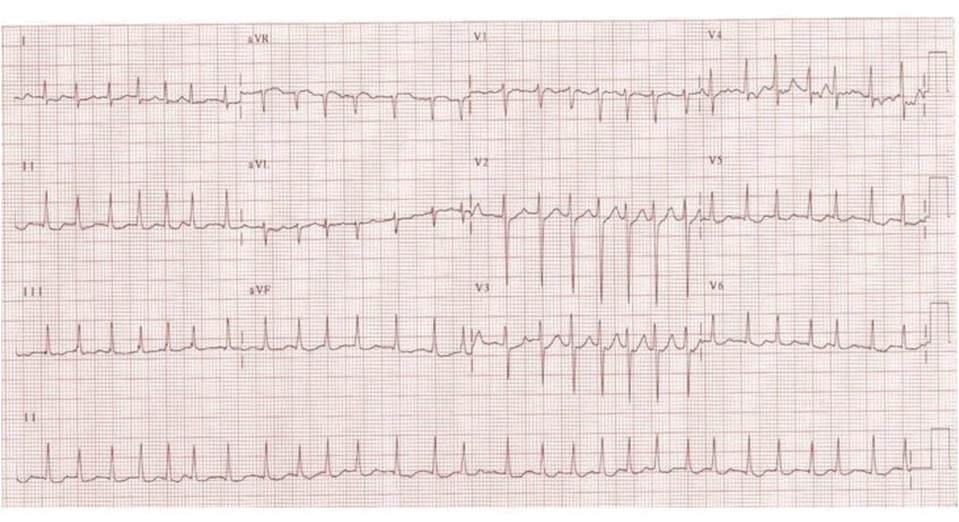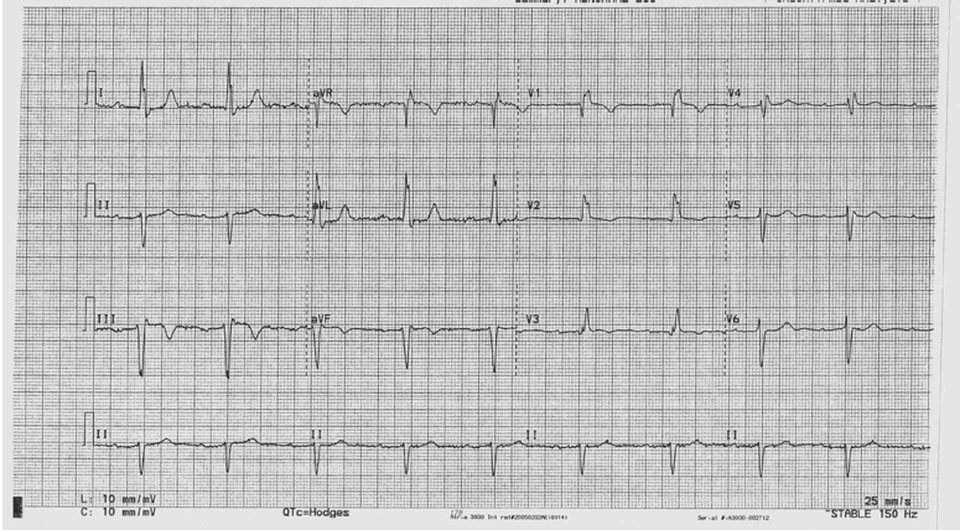MODULE FOUR short answer questions - ECG
SAQ 1.
A 79 year old man presents with "palpitations". He has never had them before, and says they began yesterday. He has developed a productive cough and intermittent fevers over the last three days.
His presentation ECG is shown below. Although not specified please assume standard calibration. (25mm/s & 1mV to 10mm)
His presentation ECG is shown below. Although not specified please assume standard calibration. (25mm/s & 1mV to 10mm)
Question 1. What is the rate? (1 mark)
168 beats per minute (28 x 6).
Question 2. Is the rhythm regular or irregular? (1 mark)
Irregular
Question 3. What is the association of atrial beats to ventricular complexes? (1 mark)
There are no p waves seen.
Question 4. Comment on the PR and QT interval. (1 mark)
Must include: (0.5 marks each)
The PR interval cannot be calculated as there are no p waves seen.
The QT interval spans >50% of the RR interval it occurs in and therefore is prolonged to the naked eye.
Question 5. What is the axis? (1 mark)
Normal as I & aVF both have large positive deflections.
Question 6. Is there an interventricular conduction defect? Why or why not? (2 marks)
Must include (0.5 marks each(
No. The QRS is of normal duration (<0.12s).
Question 7. Comment on the ST segments. (1 mark)
Flattening of ST segments in II.
No indications seen for urgent reperfusion/no gross ischaemic change.
Question 8. What is the diagnosis? (2 marks)
Atrial fibrillation with rapid ventricular response.
168 beats per minute (28 x 6).
Question 2. Is the rhythm regular or irregular? (1 mark)
Irregular
Question 3. What is the association of atrial beats to ventricular complexes? (1 mark)
There are no p waves seen.
Question 4. Comment on the PR and QT interval. (1 mark)
Must include: (0.5 marks each)
The PR interval cannot be calculated as there are no p waves seen.
The QT interval spans >50% of the RR interval it occurs in and therefore is prolonged to the naked eye.
Question 5. What is the axis? (1 mark)
Normal as I & aVF both have large positive deflections.
Question 6. Is there an interventricular conduction defect? Why or why not? (2 marks)
Must include (0.5 marks each(
No. The QRS is of normal duration (<0.12s).
Question 7. Comment on the ST segments. (1 mark)
Flattening of ST segments in II.
No indications seen for urgent reperfusion/no gross ischaemic change.
Question 8. What is the diagnosis? (2 marks)
Atrial fibrillation with rapid ventricular response.
saq 2.
A 54 year old man presents with acute central chest pain that occurred while exercising. His pain has now gone away completely. On close questioning he describes a history of exertional dyspnoea and chest discomfort over the prior month.
His ECG on presentation is shown below. Assume standard calibration of the ECG (25mm/s and 10mm to 1mV).
His ECG on presentation is shown below. Assume standard calibration of the ECG (25mm/s and 10mm to 1mV).
Question 1. Give 5 important normal findings on this ECG. (5 marks)
Must include:
- normal rate (60/min)
- 1:1 association of P & QRS complexes
Then 3 from:
- normal axis
- normal PR interval
- normal QRS duration
- normal QT interval
Question 2. What is the major electrocardiographic abnormality? (1 mark)
Deeply biphasic T waves in V2 - V4.
Question 3. What is the diagnosis? (1 mark)
Wellen's syndrome/proximal LAD lesion.
Question 4. Describe how the results of a troponin will affect your disposition of this patient. (3 marks)
Must include:
- disposition for this history and ECG is independent of troponin (1 mark)
- this patient requires an urgent PCI for LAD lesion (2 marks)
Must include:
- normal rate (60/min)
- 1:1 association of P & QRS complexes
Then 3 from:
- normal axis
- normal PR interval
- normal QRS duration
- normal QT interval
Question 2. What is the major electrocardiographic abnormality? (1 mark)
Deeply biphasic T waves in V2 - V4.
Question 3. What is the diagnosis? (1 mark)
Wellen's syndrome/proximal LAD lesion.
Question 4. Describe how the results of a troponin will affect your disposition of this patient. (3 marks)
Must include:
- disposition for this history and ECG is independent of troponin (1 mark)
- this patient requires an urgent PCI for LAD lesion (2 marks)
saq 3.
A 26 year old woman is brought to your emergency department after taking an overdose of an unknown susbtance. She has a prior history of depression and multiple overdoses in the past.
Her ECG on arrival is shown below.
Her ECG on arrival is shown below.
Question 1. What are the major abnormalities? (4 marks)
Tachycardia 108bpm
QRS >0.12s
Prolonged QT interval (>50% of RR interval)
Large R' in aVR
Question 2. Name four drugs from different classes which could cause this ECG and give an example of each. (4 marks)
Must include:
Tricyclic antidepressants (eg impiramine)
Plus any from:
Typical or atypical antipsychotics (eg droperidol or olanzapine
Anticonvulsants, specifically carbemazepine
Type 1A (Quinidine, procainamide, disopyramide) or 1C antiarrhythmics (flecainide)
Antimalarials (quinine, chloroquine, hydroxychloroquine)
Macrolides (erythmomycin, clarithromycin)
Question 3. What treatment will you administer as a matter of priority? (2 marks)
50ml NaHCO3 8.4% by slow IV push, repeated after 10-20 minutes for QT normalization.
Tachycardia 108bpm
QRS >0.12s
Prolonged QT interval (>50% of RR interval)
Large R' in aVR
Question 2. Name four drugs from different classes which could cause this ECG and give an example of each. (4 marks)
Must include:
Tricyclic antidepressants (eg impiramine)
Plus any from:
Typical or atypical antipsychotics (eg droperidol or olanzapine
Anticonvulsants, specifically carbemazepine
Type 1A (Quinidine, procainamide, disopyramide) or 1C antiarrhythmics (flecainide)
Antimalarials (quinine, chloroquine, hydroxychloroquine)
Macrolides (erythmomycin, clarithromycin)
Question 3. What treatment will you administer as a matter of priority? (2 marks)
50ml NaHCO3 8.4% by slow IV push, repeated after 10-20 minutes for QT normalization.
saq 4.
A 67 year old dialysis patient presents feeling weak and lethargic. He has missed his prior dialysis session because of a migraine.
His ECG on presentation to ED is shown below.
His ECG on presentation to ED is shown below.
Question 1. What are the major abnormalities? (4 marks)
Must include:
short PR interval
wide QRS complex >0.12s
'northwest' axis
peaked t waves
Question 2. What is the likely diagnosis? (1 mark)
Critical Hyperkalaemia
Question 3. What treatments will you administer? (5 marks)
Must include (2 marks, must specify dose):
Either Calcium Gluconate 10% 10ml as a slow IV push OR Calcium Chloride 10% 10ml as slow IV push (either for 2 marks)
Also must include: (1 mark, must specify doses)
50ml 8.4% NaHCO3
10units IV actrapid plus 50ml 50% dextrose
Salbutamol 10-20mg via nebulizer
Must include:
short PR interval
wide QRS complex >0.12s
'northwest' axis
peaked t waves
Question 2. What is the likely diagnosis? (1 mark)
Critical Hyperkalaemia
Question 3. What treatments will you administer? (5 marks)
Must include (2 marks, must specify dose):
Either Calcium Gluconate 10% 10ml as a slow IV push OR Calcium Chloride 10% 10ml as slow IV push (either for 2 marks)
Also must include: (1 mark, must specify doses)
50ml 8.4% NaHCO3
10units IV actrapid plus 50ml 50% dextrose
Salbutamol 10-20mg via nebulizer
saq 5.
A 72 year old woman presents to your department with a history of sudden syncope while at church. The nurse looking after her brings you her ECG, which is shown below.
Question 1. What are the major abnormalities? (5 marks)
Must include:
1st degree heart block (PR >0.2s)
Leftward axis
QRS >0.12s
Deep S wave in V6/RBBB
T wave inversion III, aVF
Question 2. What is the diagnosis and its implications? (2 marks)
Trifasicular block - risk factor for development of high grade arrythmias.
Question 3.
30 minutes after arrival another ECG is taken as the patient is noted to be unconscious. The ECG is shown below. What are the two major abnormalities and what therefore does the ECG show? (3 marks)Question 3. 30 minutes after arrival another ECG is taken as the patient is noted to be unconscious. The ECG is shown below. What are the two major abnormalities and what therefore does the ECG show? (3 marks)
Must include:
1st degree heart block (PR >0.2s)
Leftward axis
QRS >0.12s
Deep S wave in V6/RBBB
T wave inversion III, aVF
Question 2. What is the diagnosis and its implications? (2 marks)
Trifasicular block - risk factor for development of high grade arrythmias.
Question 3.
30 minutes after arrival another ECG is taken as the patient is noted to be unconscious. The ECG is shown below. What are the two major abnormalities and what therefore does the ECG show? (3 marks)Question 3. 30 minutes after arrival another ECG is taken as the patient is noted to be unconscious. The ECG is shown below. What are the two major abnormalities and what therefore does the ECG show? (3 marks)
Must include:
- bradycardia rate 36
- complete dissociation of P and QRS complexes
- complete heart block
- bradycardia rate 36
- complete dissociation of P and QRS complexes
- complete heart block





